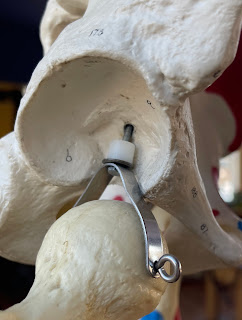Form Follows Function & Function Follows Form
As a teenager, I couldn’t decide if I found design or the human body more interesting. I voraciously read all the architecture books I could get my hands on, and also found movement and the human body endlessly interesting. When a high school project asked me to explore college programs in an area of interest, I sent away for information on programs in ergonomics (do you remember sending away for program information?)
Along the way, I became enamored with the architect Louis Sullivan’s maxim that form follows function. I particularly loved this approach to industrial design, perhaps as a reaction to the overbuilt, suburban world of my childhood. Regardless of the motives that were behind my appreciation of a minimalist design aesthetic, I found it ironic that in my career as a Kinesiologist, this maxim flipped to be function follows form.
 |
| Due to the natural variations in bony structures, some people can squat more readily than other people. |
In the body, the form of a structure predicts the function of the structure. For example, the depth of the hip socket determines the functional movement possibilities of the joint. Just because a charismatic and sometimes frightening Yoga guru says that your hip should move the same way that his hip moves doesn’t make the assertion true.
Some people have shallower hip sockets and some people have deeper hip sockets. Like some people have brown eyes and other people have green eyes, there’s not much we can do about the body we were born into, other than learn how to live within the parameters of what we’ve got. With regards to the hip, people who have shallower hip sockets generally have a greater possible range of motion than those with deeper hip sockets. Yes, you can work on mobility, though many people will experience diminishing returns as they approach the limitations of their bony structure.
Because function follows form, I find the recent uptick in programs that promise flexibility outcomes to be concerning. The human body has been molded and shaped by the unforgiving pressures of evolution. Put another way, most phenomena in the human body have a function. We may not like what occurs, though many things that occur in the body serve a function.
Stiffness in the body, for example, is often functional. In my 30+ years of actively working with bodies, I’ve found that stiffness in the body generally arises from these three causes:
- Stiffness is protecting an unstable, injured or otherwise vulnerable joint
- Stiffness is related to loss of muscle mass. While we may equate getting stiffer with getting older, the stiffness is a symptom of the problem of age-related loss of muscle mass. With less muscle mass, the remaining muscles stiffen up in order to stabilize adjacent joints.
- Stress-related stiffness. Contracting muscles when feeling stressed or scared can provide a sense of safety or protection. When stiffness is related to providing a degree of safety or protection, that stiffness was and may still be functional.
In summary, I think the best approach to working with anything in the body is to ask why? Why is this pattern present? What function may it serve? Is this situation really a problem, or a symptom of something else? With a sense of what may be causal, deprioritize working on symptom abatement and prioritize working with the cause. The human body contains a deep intelligence, and quick fixes that focus on symptoms often have unintended downstream consequences.



Comments